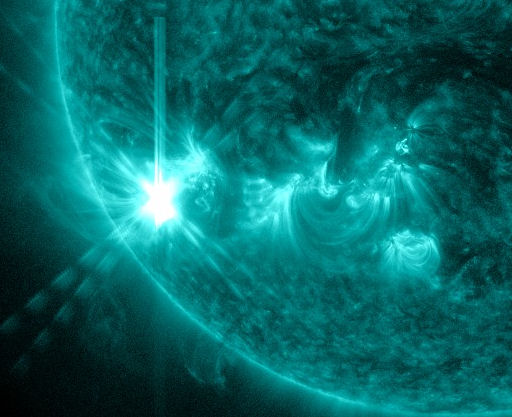They came from outer space--and you can have one! Genuine meteorites are now on sale in the Space Weather Store. | | |
MARS LANDING SKY SHOW: On the same night Curiosity lands on Mars, a "Martian Triangle" will appear in sunset skies of Earth. The first-magnitude apparition on August 5th gives space fans something to do while they wait for news from the Red Planet. [video]
M6-CLASS FLARE: Solar activity is picking up. For the second day in a row, sunspot AR1532 has unleashed a moderately-strong solar flare. The latest, an M6-class eruption, occurred on July 28th at 2056 UT. NASA's Solar Dynamics Observatory captured the extreme UV flash:

It is too soon to say if the eruption produced a coronal mass ejection (CME). If it did, Earth would likely receive no more than a glancing blow from the cloud. The sunspot is too far off disk center to be very geoeffective. This could change in the days ahead, however, as the sunspot turns toward Earth. Stay tuned for updates. Solar flare alerts: text, voice.
METEOR ACTIVITY INCREASES: Last night, NASA's All Sky Fireball Network detected 17 Venus-bright meteors. The orbits of the meteoroids, color-coded by velocity, are shown in the diagram below. Earth's location is marked by a red starburst:

The green orbits correspond to Comet 96P/Machholz, source of the annual delta Aquarid meteor shower. Although this is a minor shower, it is fraught with interest. Some researchers believe that 96P/Machholz came from another star system. Every delta Aquarid that disintegrates in the night sky could be depositing material from across the galaxy into Earth's upper atmosphere.
Forecasters expect as many as 15 delta Aquarids per hour when the shower peaks on July 28th and 29th. The best time to look, no matter where you live, is during the dark hours before sunrise on Saturday and Sunday when the moon has set and the constellation Aquarius is relatively high in the sky.
Blue orbits correspond mainly to Perseids. The Perseid meteor shower doesn't peak until August 12-13, but Earth is already in the outskirts of the debris zone of the parent comet, 109P/Swift-Tuttle. By mid-August, rates could exceed 100 meteors per hour. The show, in other words, is just getting started.
Got clouds? Try listening to meteor radar echoes on Space Weather Radio.
Realtime Space Weather Photo Gallery
Realtime Noctilucent Cloud Photo Gallery
[previous years: 2003, 2004, 2005, 2006, 2007, 2008, 2009, 2011]

